2022 Ducati Streetfighter V4 SP Review – First Ride

The Streetfighter's going all-in.
This is going to be awkward. You see, you’re about to read a piece about Ducati’s most focused Streetfighter V4 yet. You’re going to expect it to be a highly refined and special machine, worthy of the Sport Production suffix. And you know what – you’re right. It’s good. It’s very good.
Here’s the thing: they’re all sold out. Gone. Snatched up. In fact, within a week of Ducati announcing the 2022 Streetfighter V4 SP they were all spoken for. Nonetheless, you deserve to know what’s so special about it, what’s different about it over the Streetfighter V4 S, and ultimately, how it is to ride. You know, in case you’re one of the lucky ones who got one.
2022 Ducati Streetfighter V4 SP
Editor Score: 91.5%
| Engine | 19.5/20 | Suspension | 14.5/15 | Transmission | 9.5/10 |
| Brakes | 9/10 | Instruments | 4/5 | Ergonomics | 9/10 |
| Appearance | 9.5/10 | Desirability | 9.5/10 | Value | 7/10 |
+ Highs
- Carbon wheels up the SF’s performance dramatically
- Panigale V4 suspension adds cruical support when riding hard
- One of our favorite thrill rides is even better
– Sighs
- You’re going to wish you had wind protection at 175 mph
- The dry clutch is heavier? Oh, the irony
- They’re all spoken for
Ducati Resurgence
Wouldn’t you know it, 2021 proved to be Ducati’s best sales year ever, despite a global pandemic. I guess a couple years being locked down forced people to save up some money, while simultaneously inspiring those people to live for today, since who knows what might end the world tomorrow. With this newfound piggy bank and inspiration, more people flocked to the Ducati Panigale V4S than ever before (Ducati’s single best-selling model that year).
Then, when Borgo Panigale decided to up the ante and revive the SP – or Sport Production – name for the Panigale V4 SP2, on went the carbon fiber wheels, STM dry clutch, Brembo Stylema R calipers, and a host of other small changes to make it even more track-focused. Guess what? It sold out in no time.
The next step was obvious. If it’s good enough for the Panigale, then let’s do it to the Streetfighter. Hence, the 2022 Ducati Streetfighter V4 SP was born.
What Makes A Streetfighter An SP?
It all starts, of course, with the Streetfighter V4S, a favorite among the Motorcycle.com staff. With a claimed 208 horsepower on tap, the 1103cc, twin-pulse, counter-rotating V4 is left alone – except for one thing: an STM dry clutch. Ostensibly, the dry clutch provides better power transfer, but let’s not overlook the fact that it’s there because no Ducati sportbike is quite right without a dry clutch. The clackety-clack of a dry clutch is quintessential Ducati, and hearing it again on the Streetfighter SP just seems… right.
Besides the brushed aluminum tank in place of the bright red one, another obvious difference is the carbon fiber wheels – the same ones you’ll find on the Panigale V4 SP2. They shave off 3 lbs compared to the forged aluminum wheels on the Streetfighter V4S, and even if you’ve been living under a rock, the handling advantages of carbon wheels (or light wheels in general) are very well known.
Less known is a small but significant change in the Streetfighter SP suspension. Both front and rear now wear the same electronic Öhlins pieces as the MY2021 Panigale V4. Traditionally, the Streetfighter served the role as the road-oriented sportbike while the Panigale was track-focused. This meant suspension settings leaning on the softer side for the Streetfighter. With the SP, adopting the Panigale suspension firmly plants it (get it?) as a track weapon. Specifically, the fork, while externally the same between both models, now gets stiffer springs (10 N/mm vs. 8.5 N/mm), less spring preload (from 11mm to 6mm) different fork oil level, and different shim stacks, making it identical with the Panigale. The shock goes from an 80 N/mm spring to 85 N/mm and also receives identical valving with the Panigale.
From there, we see other subtle differences, like shorter, adjustable rearsets in machined aluminum, Brembo Stylema R calipers, a Brembo MCS 19/21 front brake master cylinder, and a lithium ion battery. You’ll find an embossed number on the handlebar, but the Streetfighter SP is not a limited edition model.
Add it all up and Ducati says the Streetfighter V4 SP weighs 7 lbs less than the S model it’s based on. It could slash that weight savings even further if it weren’t for the dry clutch. Ironically enough, the very item that sparks so much emotion among Ducatisti carries with it some baggage. You need a stronger clutch basket to run a dry clutch, and in this case stronger means heavier. So much for having your cake and eating it, too. Though the tradeoff clearly hasn’t impacted the SP’s popularity considering it’s nearly impossible to get one.
Lighter. Faster. Still Surprising.
By now, you’re conditioned to know that up-spec models perform better than the models they’re based on. I am too. But without riding them back-to-back, it’s hard to truly appreciate the differences between a Streetfighter V4 S and an SP. The Streetfighter V4S is already one of MO’s favorite motorcycles thanks to its ability to do a little bit of everything. What’s it like when it’s groomed for the track?
Thankfully, Ducati had both models on hand during a track outing at the Cremona circuit in Northern Italy, where only a select group of journalists were invited to see the differences for themselves, and Yours Truly was the only North American. Many Americans may not be familiar with the track as it doesn’t have the prestige as, say, a Mugello or Misano, but the 2.3-mile track is a fun and challenging circuit, and one where Ducati regularly tests its new motorcycles.
Those in the know about what it takes to find speed at the track already know the advantages of carbon fiber wheels. Compared to the wheels on the V4S – which is already no slouch – the carbon wheels on the SP allow the rider to huck on the bars and noticeably change direction with less effort, resulting in the ability to place the bike where you want it easier.
The real surprise was feeling the difference in acceleration between the forged S wheels and the carbon SP’s. Coming off the corner and giving it the berries, it feels as though the 1103cc V4 of the SP suddenly found a few more horses. It hasn’t, but with less rotating mass to turn, you feel the SP leap out of corners with greater authority compared to the aluminum wheels on the S model.
The other difference you especially notice when riding the S and SP back-to-back comes from the suspension. With an overall stiffer setup, the SP really stands out in the Turn 5-6 complex at Cremona. You charge through the right-hand Turn 5 and start using the brakes after the apex to set up for the tight right at Turn 6. Having to brake while leaned over is a scary proposition to begin with, and while the S feels relatively stable going in, the SP delivers so much more confidence to charge into the complex at a higher rate, then get on the brakes with more lean. The firmer settings give the rider more braking support, especially in the bottom half of the stroke, to tighten the line, hit the Turn 6 apex, and fire the bike out. Obviously, the front end confidence carries over to the rest of the track as well, but nowhere is it more important than in these two turns.
With more confidence to lean over, comes the greater chance of scraping toes. Not so with the SP and its shorter, higher pegs. Once you get pushing on the V4S, grinding pegs and toe sliders on the ground becomes a common occurrence. With the SP’s pegs though, this is a thing of the past. The knurled pegs provide more grip for your feet, too, since there’s less peg to grasp onto. It’s attention to details like this that help the SP stand out from the S.
As far as the rest of the bike is concerned, you already know the Streetfighter V4 is one fast motorcycle. It proves it every time it goes down the nearly one kilometer long back straight at Cremona, as the screaming V4 hurtles the bike to 286 kph before popping up for the brakes. Without any wind protection to shield you, it’s a rush to the senses and a real test of your neck muscles every time!
Needless to say, the Streetfighter is ready and waiting to rip your arms off at any opportunity, which is why I’m glad Ducati decided to leave well enough alone with the engine. Same goes for the excellent electronics, too. I’ve called it some of the best electronics in the business, and for good reason – it’s been developed with a big helping hand from the Ducati Corse racing team. The throttle mapping between the right hand and rear wheel brings with it a very direct connection, but many of the safety features like traction control, slide control, and wheelie control are so seamlessly integrated you don’t notice them working in the background.
But Is It Faster?
If Ducati is billing the SP as the ultimate track expression of the Streetfighter, then you probably want to know if it’s faster around the track than the S. The truth is…I don’t know. It would make sense, considering the changes. But having never been to Cremona before, a lap time comparison between my early laps on the S, while still learning the track, and my later laps on the SP, when I had a better understanding of where to go, would be disingenuous.
Still, other journos commented they saw as much as two seconds difference between their laps on the S and SP. Bear in mind, none of the journos (except the Italian) had seen Cremona before. One quote that stood out for me came from one of the Brits in attendance – “The lap time [on the onboard lap timer] clearly shows I was faster, but I put in the same amount of effort [between the S and SP].” For what it’s worth, I felt like I was going faster on the SP.
Lucky Devils
In case you didn’t notice by now the Streetfighter V4 SP is a thrill ride among thrill rides, and proves how some choice changes can elevate a motorcycle to new heights. But this is where we come full circle with the beginning of this story, because you clearly don’t need me to tell you what a thrill it is to ride. The public decided that a while ago with their wallets, and if you’re one of the few who have your hands on a Streetfighter V4 SP, consider yourself lucky. But don’t take my word for it – give it a proper flog and see. Just remember to hang on.
In Gear

Helmet: Arai Corsair-X Nicky Reset
- Suit: Alpinestars GP Tech V4
- Airbag: Alpinestars Tech-Air 5
- Gloves: Alpinestars GP Pro R3
2022 Ducati Streetfighter V4 SP Specifications | |
|---|---|
| Engine Type | Desmosedici Stradale 90° V4, rearward-rotating crankshaft, 4 Desmodromically actuated valves per cylinder, liquid cooled |
| Displacement | 1,103 cc |
| Bore x Stroke | 81.0 mm x 53.5 mm |
| Compression Ratio | 14.0:1 |
| Power | 208 hp at 12,750 rpm (claimed) |
| Torque | 90.4 lb-ft. at 11,500 rpm (claimed) |
| Fuel Injection | Electronic fuel injection system. Twin injectors per cylinder. Full ride-by-wire elliptical throttle bodies. |
| Exhaust | 4-2-1-2 system, with 2 catalytic converters and 2 lambda probes. |
| Gearbox | 6 speed with Ducati Quick Shift (DQS) up/down EVO 2 |
| Primary drive | Straight cut gears; Ratio 1.80:1 |
| Ratio | 1=38/14 2=36/17 3=33/19 4=32/21 5=30/22 6=30/24 |
| Final drive | Chain 525; Front sprocket 15; Rear sprocket 42 |
| Clutch | Hydraulically controlled slipper dry clutch. Self bleeding master cylinder |
| Frame | Aluminum alloy “Front Frame” |
| Front suspension | Öhlins NIX30 43 mm fully adjustable fork with TiN treatment. Electronic compression and rebound damping adjustment with Öhlins Smart EC 2.0 event-based mode |
| Front Wheel | 5-split spoke carbon fiber 3.50″ x 17″ |
| Front Tyre | Pirelli Diablo Rosso Corsa II 120/70 ZR17 |
| Rear suspension | Fully adjustable Öhlins TTX36 unit. Electronic compression and rebound damping adjustment with Öhlins Smart EC 2.0 event-based mode. Aluminum single-sided swingarm |
| Rear Wheel | 5-split spoke carbon fiber 6.00″ x 17″ |
| Rear Tyre | Pirelli Diablo Rosso Corsa II 200/60 ZR17 |
| Wheel Travel (Front/Rear) | 120 mm (4.7 inches) – 130 mm (5.1 inches) |
| Front Brake | 2 x 330 mm semi-floating discs, radially mounted Brembo Monobloc Stylema R 4-piston callipers with Bosch Cornering ABS EVO. Self bleeding master cylinder |
| Rear Brake | 245 mm disc, 2-piston calliper with Bosch Cornering ABS EVO |
| Instrumentation | Last generation digital unit with 5″ TFT colour display |
| Dry Weight | 390 pounds (claimed) |
| Kerb Weight | 432 pounds (claimed) |
| Seat Height | 845 mm (33.3 inches) |
| Wheelbase | 1.488 mm (58.6 inches) |
| Rake | 24,5° |
| Trail | 100 mm (4 inches) |
| Fuel Tank Capacity | 16 l – 4.23 gallon (US) |
| Number of Seats | Single seat |
| Safety Equipment | Riding Modes, Power Modes, Bosch Cornering ABS EVO, Ducati Traction Control (DTC) EVO 2, Ducati Wheelie Control (DWC) EVO, Ducati Slide Control (DSC), Engine Brake Control (EBC) EVO, Auto tyre calibration |
| Standard Equipment | Ducati Power Launch (DPL), Ducati Quick Shift (DQS) up/down EVO 2, Full LED lighting with Daytime Running Light (DRL), Ducati Electronic Suspension (DES) EVO with Öhlins suspension and steering damper, Quick adjustment buttons, Auto-off indicators, Carbon fiber wheels, Carbon fiber front mudguard, Wings in carbon fiber, Adjustable rider footpegs in aluminum with heel guard in carbon fiber, Lithium-ion battery |
| Provided Equipment | Carbon fiber open clutch cover*, Removing license plate holder kit* *This product is intended for vehicles used only in closed-course circuit. Operation on public roads is prohibited by law. |
| Ready for | Ducati Data Analyser+ (DDA+) with GPS module, Ducati Multimedia System (DMS), Anti-theft, Heated grips |
| Warranty | 24 months unlimited mileage |
| Maintenance Service Intervals | 12,000 km (7,500 miles) / 12 months |
| Valve Clearance Check (Desmoservice) | 24,000 km (15,000 miles) |
We are committed to finding, researching, and recommending the best products. We earn commissions from purchases you make using the retail links in our product reviews. Learn more about how this works.
Become a Motorcycle.com insider. Get the latest motorcycle news first by subscribing to our newsletter here.

Troy's been riding motorcycles and writing about them since 2006, getting his start at Rider Magazine. From there, he moved to Sport Rider Magazine before finally landing at Motorcycle.com in 2011. A lifelong gearhead who didn't fully immerse himself in motorcycles until his teenage years, Troy's interests have always been in technology, performance, and going fast. Naturally, racing was the perfect avenue to combine all three. Troy has been racing nearly as long as he's been riding and has competed at the AMA national level. He's also won multiple club races throughout the country, culminating in a Utah Sport Bike Association championship in 2011. He has been invited as a guest instructor for the Yamaha Champions Riding School, and when he's not out riding, he's either wrenching on bikes or watching MotoGP.
More by Troy Siahaan










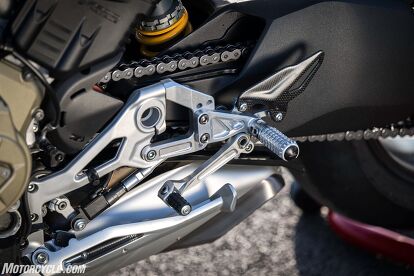






















































































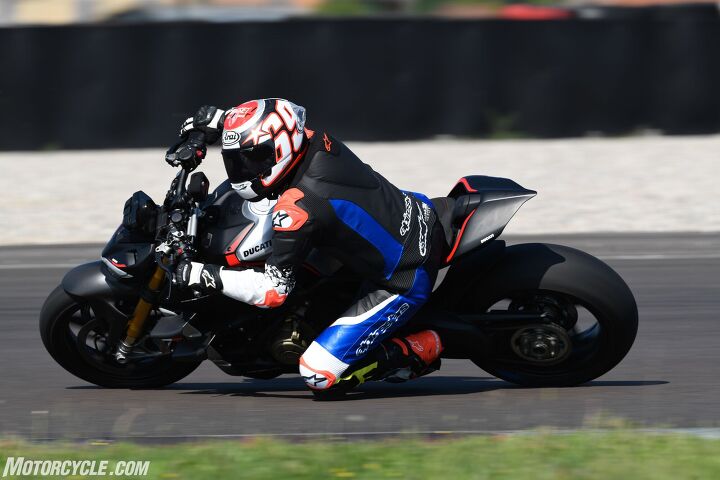









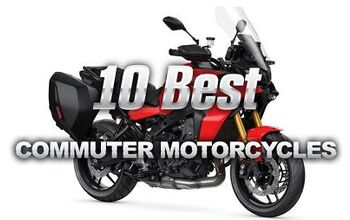






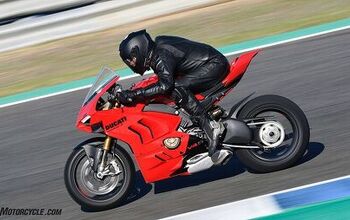

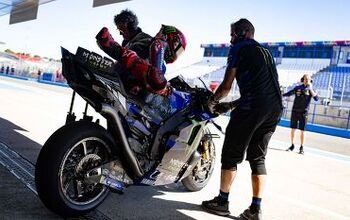








Comments
Join the conversation
Magnificent motorcycle but I never warmed up to the look, $$$$$ and DESMO.
Bring on a Monster with the V4 Granturismo.
What! No video!